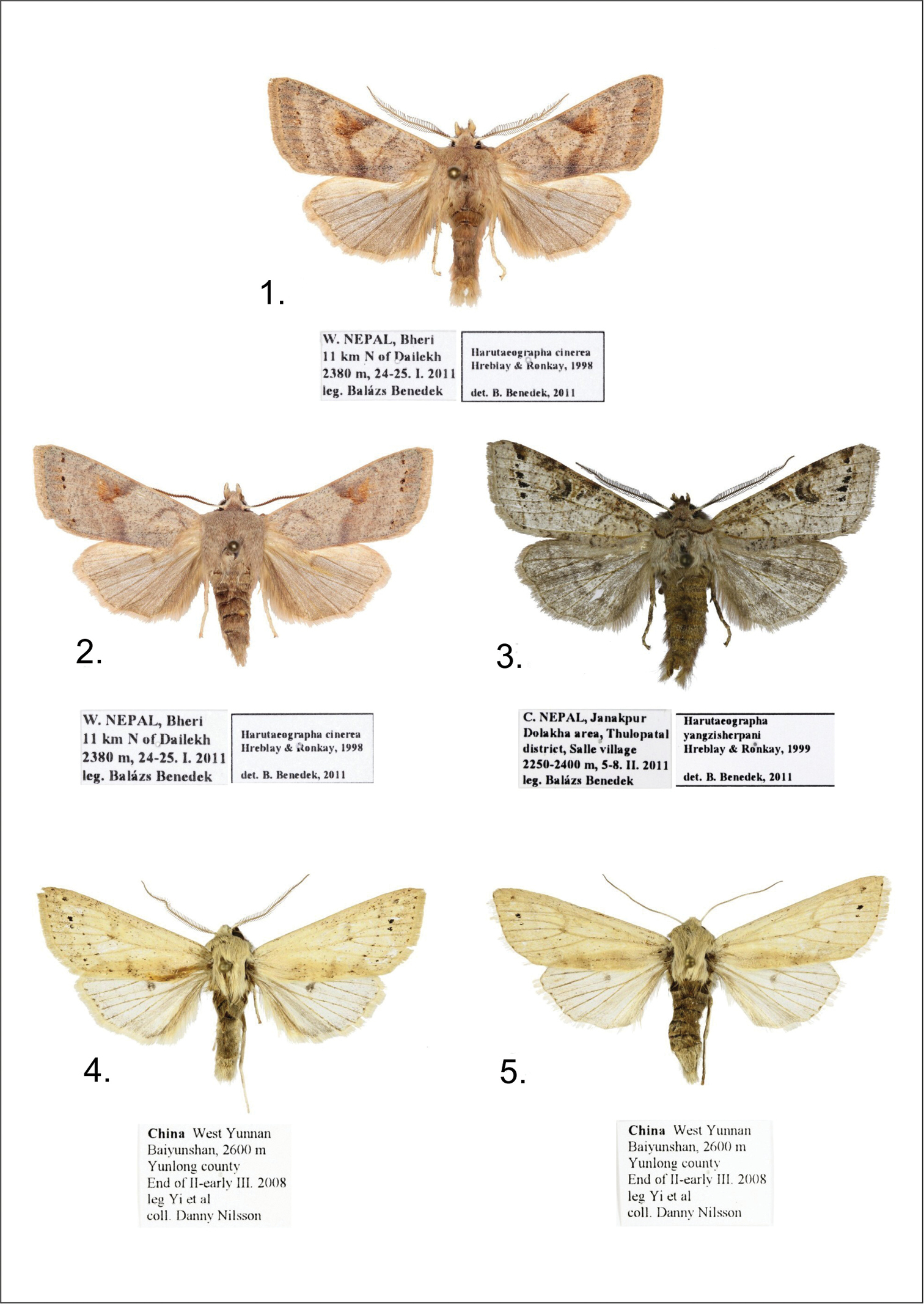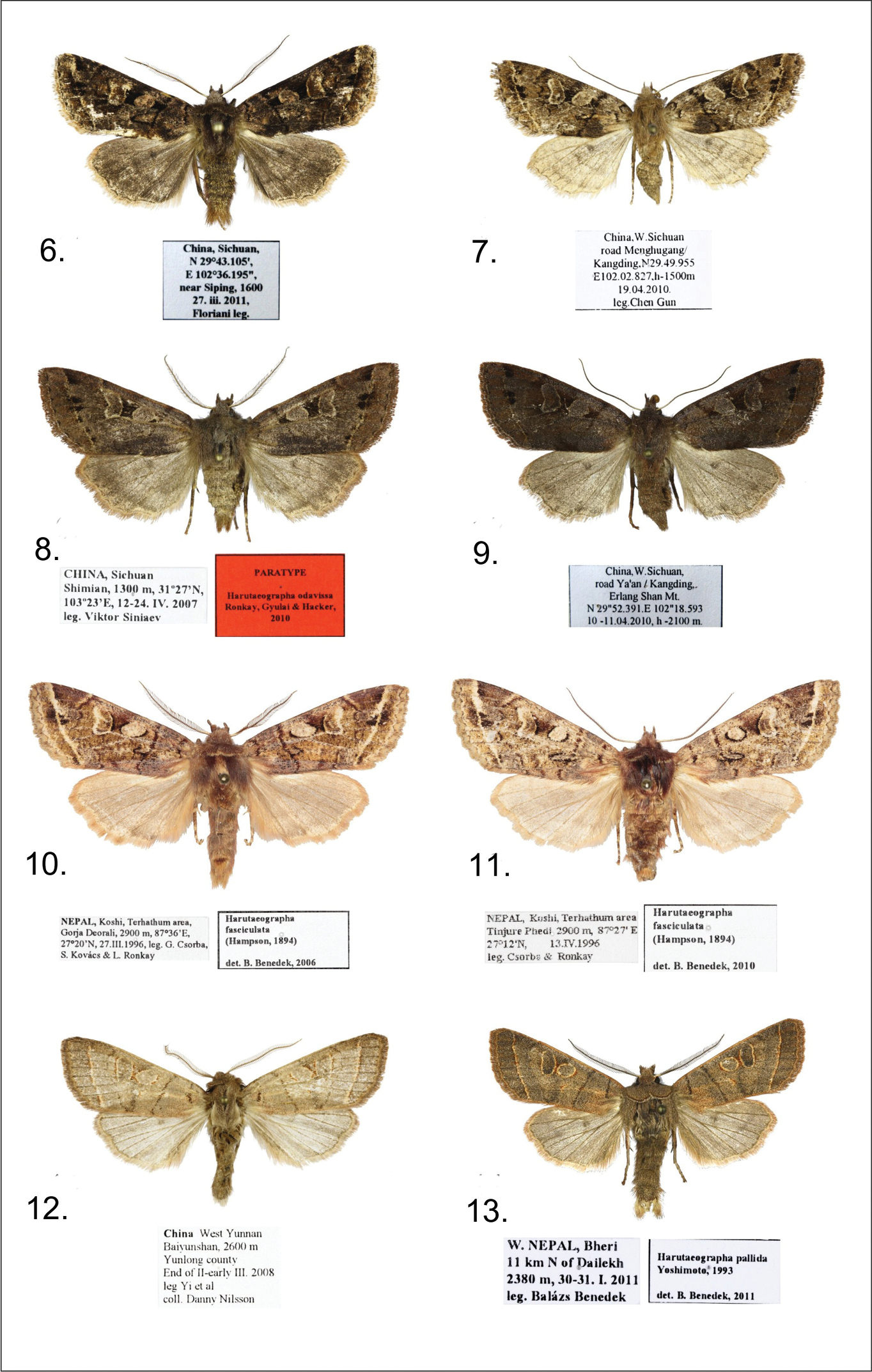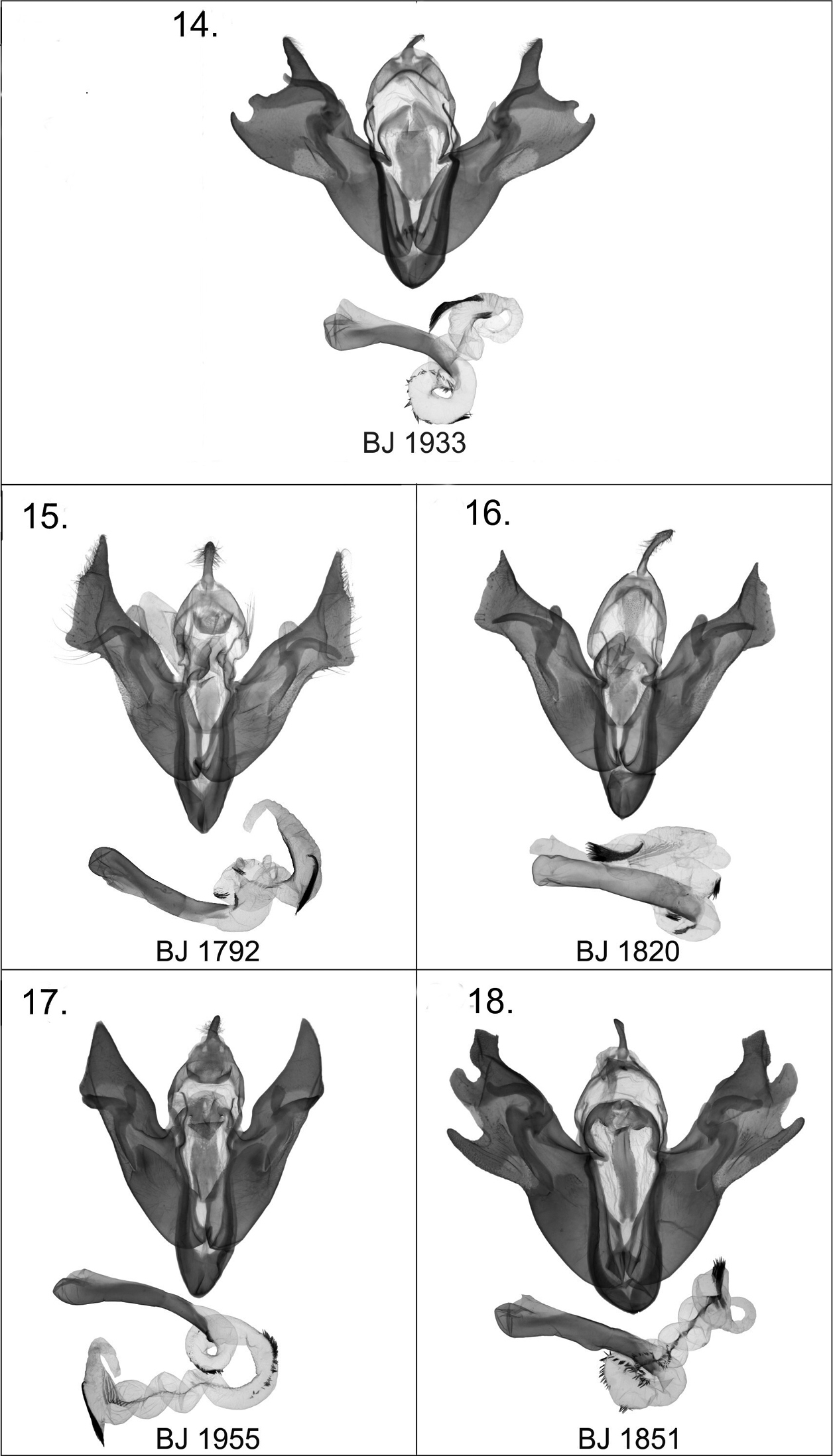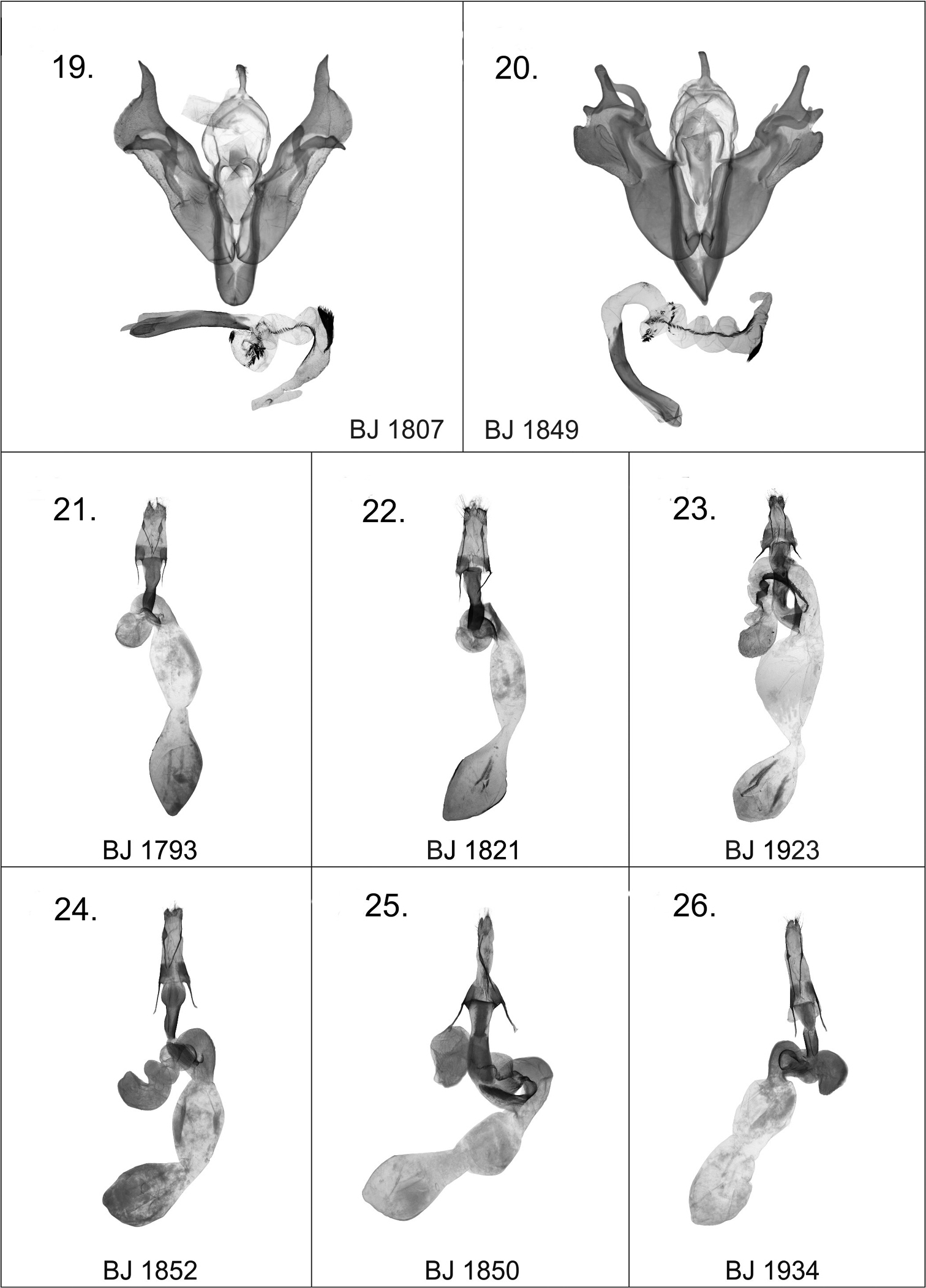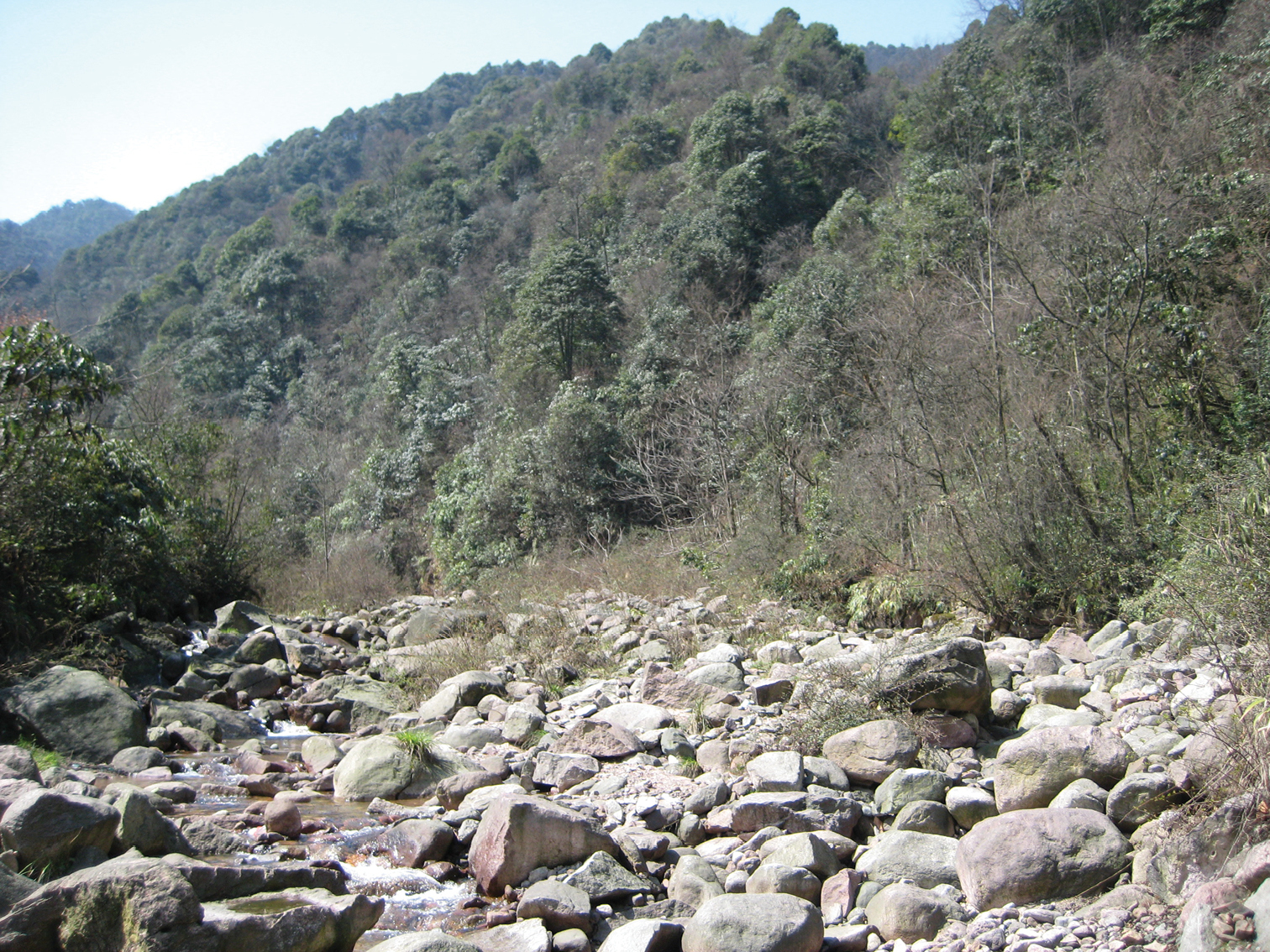






(C) 2012 Balázs Benedek. This is an open access article distributed under the terms of the Creative Commons Attribution License 3.0 (CC-BY), which permits unrestricted use, distribution, and reproduction in any medium, provided the original author and source are credited.
For reference, use of the paginated PDF or printed version of this article is recommended.
Description of anew Harutaeographa Yoshimoto, 1993 species, Harutaeographa shui sp. n. from China’s Sichuan province, is given. Harutaeographa yangzisherpani transformis Hreblay & Ronkay, 1999 is combined as a synonym of Harutaeographa yangzisherpani yangzisherpani Hreblay & Ronkay, 1999. Additional distributional data for Harutaeographa pallida Yoshimoto, 1993, and Harutaeographa cinerea Hreblay & Ronkay, 1998 are provided. A checklist of the genus Harutaeographa and a key to the Harutaeographa fasciculata (Hampson, 1894) species-group, based on external characters and genitalia, are presented.
Orthosiini, new species, Harutaeographa, distribution
This paper contributes additional taxonomic, genitalic and faunistic information on the taxonomy of the genus Harutaeographa Yoshimoto, 1993 to what was previously provided in
The specimens of Harutaeographa preserved in the collections of Alessandro Floriani (Milan, Italy), Balázs Benedek (Törökbálint, Hungary), Gottfried Behounek (Grafing, Germany)/Zoologische Staatssammlung, Munich (Germany), Danny Nilsson (Kalvehave, Denmark) and Nature Research Centre (Vilnius, Lithuania) were examined. The specimens examined were collected in China and Nepal using ultraviolet light traps and occasionally sugar ropes. Seventeen genital slides were prepared and 27 photographs were made. Examination of morphology: after maceration, male and female genitalia were dissected and mounted in euparal on glass sides. Dissection of genitalia follows
Abbreviations of the material depositories:
AFM Alessandro Floriani (Milan, Italy);
BBT Balázs Benedek (Törökbálint, Hungary);
BMNH Natural History Museum, London (United Kingdom);
DNK Danny Nilsson (Kalvehave, Denmark);
HNHM Hungarian Natural History Museum, Budapest (Hungary);
MNHU Museum für Naturkunde Leibniz Institute for Research on Evolution and Biodiversity, Berlin (Germany);
NHM Naturhistorisches Museum Wien (Austria);
NRCV Nature Research Centre (Vilnius, Lithuania);
NSMT National Science Museum Tokyo (Japan);
ZFMK Zoological Forschungsinstitut und Museum Alexander Koenig, Bonn (Germany);
ZMH Zoological Museum of Helsinki (Finland);
ZSM Zoologische Staatssammlung, Munich (Germany).
Systematic accountsKey to Harutaeographa species related to Harutaeographa fasciculata based on external characters
| 1 | Forewings dark brown with black pattern or patches of dark scales | 2 |
| Forewings light brown, orbicular stigma whitish (Figs 10, 11) | Harutaeographa fasciculata (Himalaya: Sikkim, N.India; Nepal) | |
| 2 | Wingspan of forewings 37–42 mm, forewings narrow, cilia golden yellow (Figs 6, 7) | Harutaeographa shui (China: Sichuan) |
| Wingspan of forewings 42–48 mm, forewings wide, cilia dark brown (Figs 8, 9) | Harutaeographa odavissa (China: Shaanxi, Hubei, Sichuan) |
Key to Harutaeographa species related to Harutaeographa fasciculata based on genital characters
| 1 | Valva at apex widening, clasper curved, ductus bursae straight | 2 |
| – | Valva not widening at apex, clasper almost straight, ductus bursae curved at base (Figs 17, 23) | Harutaeographa fasciculata |
| 2 | Uncus short, apical part of cucullus a boot-shaped plate with short blunt apex, ampula long, curved at apex, almost perpendicular to costa, both anterior and posterior parts of corpus bursae almost equal in size (Figs 15, 21) | Harutaeographa shui sp. n. |
| – | Uncus 1/3 longer than in Harutaeographa shui, apical part of cucullus boot-shaped with short acute apex, ampula slightly curved at apex, posterior part of corpus bursae longer and narrower than anterior part (Figs 16, 22) | Harutaeographa odavissa |
urn:lsid:zoobank.org:act:C3F72129-2643-4234-84F6-ABEA933B13A8
http://species-id.net/wiki/Harutaeographa_shui
Figs 6, 7, 15, 21Holotype:male (Fig. 6), China, Sichuan, 29°43.105'N, 02°36.195'E, near Siping, 1600 m, 27.iii.2011, Floriani leg., in the collection of ZSM; (slide No. JB1792m).
Paratypes: 3 males, with the same data as the holotype, 1 male, from the same locality, but 02.iv.2011, 1 female (Fig. 7), China, W. Sichuan, road Menghugang/Kangding, 29°49.955'N, 102°02.827'E, 1500 m, 19.iv.2010, leg. Chen Gun, in the AFM, BBT, and ZSM collections. Slide No. JB1793f.
The specific name refers to the Shu Kingdom, which is now Chengdu, the capital of China’s Sichuan province.
Harutaeographa shui in general appearance is similar to Harutaeographa fasciculata (Hampson, 1894) (Figs 10, 11), but is smaller and has more oblong forewings. Despite this superficial resemblance to Harutaeographa fasciculata, based on genital morphology the new species is more closely related to Harutaeographa odavissa Ronkay, Ronkay, Gyulai & Hacker, 2010 (Figs 8, 9). These species are easily distinguishable externally by forewing shape, coloration and pattern. The male genitalia differ from those of Harutaeographa odavissa (Fig. 16)by its shorter uncus, smaller tegumen, remarkably broader and apically more elongate cucullus, and the configuration of the clasper-ampulla complex. The structure of aedeagus and vesica are similar to those of Harutaeographa odavissa (Fig. 16), but Harutaeographa shui (Fig. 15) has a slightly more curved aedeagus, differently configured vesica, and longer subterminal cornuti field. The female genitalia of the new species differ from those of Harutaeographa odavissa (Fig. 22) in having a shorter ovipositor, shorter apophyses, and shorter and weaker ductus bursae.
Wingspan 37–42 mm, length of forewing 17–20 mm. Head, front and thorax chocolate brown with some copper shine; male antenna bipectinate, female antenna narrow ciliate; forewings richly decorated with dark coppery-brown patterns distinctly marked with black scales, outer margin and cilia lighter golden yellow; hindwings with intensive dark suffusion, especially wide on outer margin, discal spot, and well-marked postmedial fascia; cilia with copper shine. Male genitaila (Fig. 15): uncus short, evenly broad; tegumen small and low; vinculum strong, narrow, V-shaped; valva finely arcuate; cucullus broad with apex elongate; sacculus weak, less sclerotized; clasper and ampulla robust outside and turned at middle; aedeagus rather long, gently arcuate; vesica with two subbasal coils and a small rasp-plate at base near carina, two small bunches of stronger cornuti in subbasal coils, and a long brush-like cornuti field on arcuate subterminal area. Female genitalia (Fig. 21): ostium nearly evenly truncated; ductus bursae narrow, somewhat wider and less sclerotized posteriorly; appendix bursae relatively small and rounded, weakly sclerotized; corpus bursae elongated, mesially constricted, with anterior and posterior parts subequal.
The new species is known only from Siping and Kangding areas of Sichuan Province (China), on the eastern edge of Tibetan plateau, where a few specimens were collected at the end of March – beginning of April at altitudes ranging from 1500 to 1600 m. It was attracted to light during cold (2–4 ˚C) nights in small river valleys. The habitat is mountain virgin mixed forest dominated by various broad-leaved trees, rhododendrons and bamboos (Fig. 27).
Harutaeographa ssp. adults. 1 Harutaeographa cinerea, male, West-Nepal, Bheri (BBT) 2 Harutaeographa cinerea, female, West-Nepal, Bheri (BBT) 3 Harutaeographa yangzisherpani yangzisherpani, male, Nepal, Janakpur (BBT) 4 Harutaeographa monimalis, male, China, W. Yunnan (DNK) 5 Harutaeographa monimalis, female, China, W. Yunnan (DNK)
Harutaeographa ssp. adults. 6 Harutaeographa shui, male, holotype, China, Sichuan (GBG/ZSM) 7 Harutaeographa shui, female, paratype, China, Sichuan (AFM) 8 Harutaeographa odavissa, male, paratype, China, Sichuan (BBT) 9 Harutaeographa odavissa, female, China, Sichuan (BBT) 10 Harutaeographa fasciculata, male, Nepal, Koshi (BBT) 11 Harutaeographa fasciculata, female, Nepal, Koshi (BBT) 12 Harutaeographa pallida, male, China, W. Yunnan (DNK) 13 Harutaeographa pallida, male, West-Nepal, Bheri (BBT)
http://species-id.net/wiki/Harutaeographa_monimalis
Figs 4, 5, 18, 241 male, 1 female, China, W. Yunnan, Baiyunshan, 2600 m, Yunlong county, end of ii - early iii.2008, leg. Yi et al, in the collection of DNK; slide Nos JB1851m (Fig. 18); JB1852f.
Male genitalia. Uncus small, elongated; tegumen short; juxta long, tongue-shaped, more or less quadrangular; vinculum short and heavily sclerotised, U-shaped; sacculus broad, with more or less parallel margins. Clasper relatively large, thumb-like, with elongated and heavily sclerotised base; clasper fused with relatively small and evenly curved ampulla. Valvae more or less symmetrical, broad, armed with strong, finger-shaped ventral process and large, broad digitus; cucullus broad and strong, more or less rhomboidal in shape. Aedeagus relatively long, straight and broad; vesica evenly helicoid in shape, everted ventrally, covered with a row of fine spiculi from basal part of vesica along to terminal segment where it merges into a stouter cluster of longer spines forming a brush-like structure. Female genitalia (Fig. 24): Ostium bursae wide, rounded; ductus relatively short; appendix bursae helicoid with three coils; corpus bursae constricted mesially with both anterior and posterior sections broadly elliptical.
This is the first new report of this species known previously only by its holotype specimen collected by Dr. H. Höne in 1935 (coll. ZFMK, Bonn).
http://species-id.net/wiki/Harutaeographa_yangzisherpani_transformis
Figs 3, 192 males, Nepal, Janakpur, Dolakha area, Thulopatal district, Salle village, 2250–2400 m, 27°35.998'N, 86°09.775'E 5–8.ii.2011, leg. Balázs Benedek, in the collection of BBT; slide No. JB1807m (Fig. 19).
The genitalia of Harutaeographa yangzisherpani yangzisherpani Hreblay & Ronkay, 1999 from Nepal exactly match those of Harutaeographa yangzisherpani transformisHreblay & Ronkay from N. Vietnam pictured in Esperiana, 1999. The very slight genital differences betweenHarutaeographa yangzisherpani yangzisherpani Hreblay & Ronkay, 1999 and Harutaeographa yangzisherpani transformisHreblay & Ronkay, 1999, suggest that they representing the same taxon and it is not reasonable to separate them as subspecies. Thus, Harutaeographa yangzisherpani transformisHreblay & Ronkay, 1999 is combined here as a synonym of Harutaeographa yangzisherpani yangzisherpani Hreblay & Ronkay, 1999. It is first report of this species from Nepal.
Harutaeographa ssp. male genitalia. 14 Harutaeographa cinerea, male, prep. BJ1933m 15 Harutaeographa shui, male, holotype, prep. BJ1792m 16 Harutaeographa odavissa, male, paratype, prep. BJ1820m 17 Harutaeographa fasciculata, male, prep. BJ1955m 18 Harutaeographa monimalis, male, prep. BJ1851m
Harutaeographa ssp. male and female genitalia. 19 Harutaeographa yangzisherpani yangzisherpani, male, prep. BJ1807m 20 Harutaeographa pallida, male, prep. BJ1849m 21 Harutaeographa shui, female, paratype, prep. BJ1793f 22 Harutaeographa odavissa, female, prep. BJ1821f 23 Harutaeographa fasciculata, female, prep. BJ1923f 24 Harutaeographa monimalis, female, prep. BJ1852f 25 Harutaeographa pallida, female, prep. BJ1850f 26 Harutaeographa cinerea, female, prep. BJ1934f
http://species-id.net/wiki/Harutaeographa_pallida
Figs 12, 13, 20, 251 female, West-Nepal, Bheri, Dailekh area, 11 km N of Dailekh, 2380 m, 24–25.i.2011, 1 male, West-Nepal, Bheri, Dailekh area, 11 km N of Dailekh, 2380 m, 30–31.i.2011, 2 males, Nepal, Janakpur, Dolakha area, Thulopatal district, Salle village, 2250–2400 m, 5–8.i.2011, leg. Balázs Benedek, 3 males, 1 female, China, W. Yunnan, Baiyunshan, 2600 m, Yunlong county, end of ii - early iii.2008, leg. Yi et al, in the collections of BBT and DNK; slide Nos JB1849m, JB1850f, (Figs 20, 25).
These specimens, which are paler in colour than those from Nepal, are the first to be reported from China.
http://species-id.net/wiki/Harutaeographa_cinerea
Figs 1, 2, 14, 26long series of both sexes from the following localities: West-Nepal, Bheri, Dailekh area, 11 km N of Dailekh, 2380 m, 24–25.i.2011, West-Nepal, Bheri, Dailekh area, 13 km N of Dailekh, 2425 m, 26–27.i.2011, West-Nepal, Bheri, Dailekh area, 12 km N of Dailekh, 2600 m, 29.i.2011, West-Nepal, Bheri, Dailekh area, 11 km N of Dailekh, 2380 m, 30–31.i.2011, Nepal, Janakpur, Dolakha area, Thulopatal district, Salle village, 2250–2400 m, 5-8.ii.2011, leg. Balázs Benedek, in the collection of BBT.
Little information has been available for this species due to insufficient collecting during its very early flight period (
Harutaeographa shui, type locality, China, Sichuan near Siping.
Harutaeographa adusta Hreblay & Ronkay, 1999
Holotype: coll. M. Hreblay, HNHM. Type locality: Thailand, Changwat Chiang Mai, Mt. Doi Inthanon. Distribution: Indochina, Thailand.
Harutaeographa akos Hreblay, 1996 [1997]
Holotype: ZMH. Type locality: Tadjikistan, Gissar-Gebirge, Romit. Distribution: Tadjikistan (Gissar Mts.).
Harutaeographa babai Sugi & Sakurai, 1994
Holotype: NSMT. Type locality: Nepal, Dhaulagiri, Jomsom. Distribution: Nepal; Himalaya.
Harutaeographa bidui bidui Hreblay & Plante, 1996 [1997]
Holotype: coll. M. Hreblay, HNHM. Type locality: N.Pakistan, 5 km S Rattu. Distribution: Himalaya: N. Pakistan (Karakorum, Prov. Gilgit & Baltistan, Rattu, Prov. Jammu & Kashmir, Deosai Mts.).
Harutaeographa bidui kaghanensis Hreblay & Ronkay, 1999
Holotype: coll. Hreblay, HNHM. Type locality: Pakistan, Prov. NW-Frontier, Kaghan valley, Khanian. Distribution: Pakistan (Prov. NW-Frontier, Kaghan valley, Khanian).
Harutaeographa bicolorata Hreblay & Ronkay, 1998
Holotype: coll. Hreblay, HNHM. Type locality: Nepal, Ganesh Himal, 1 km E Gadrang. Distribution: Himalaya: Nepal (Ganesh Himal).
Harutaeographa brahma Hreblay & Ronkay, 1998
Holotype: coll. Hreblay, HNHM. Type locality: Nepal, Ganesh Himal, 2 km W Thangjet. Distribution: Himalaya: Nepal (Ganesh Himal).
Harutaeographa brumosa Yoshimoto, 1994
Holotype: NSMT. Type locality: Nepal, Janakpur, Jiri. Distribution: Himalaya: Nepal (Janakpur, Jiri, Terhathum distr.).
Harutaeographa caerulea caerulea Yoshimoto, 1993
Holotype: NSMT. Type locality: Nepal, Mt. Phulchouki. Distribution: Himalaya: Nepal (Katmandu Valley, Godavari).
Harutaeographa caerulea rubrigrapha Hreblay & Ronkay, 1999
Holotype: coll. Hreblay, HNHM. Type locality: Thailand, Changwat Chang Mai, Mt. Doi Phahompok, 18 km NW Fang. Distribution: Indochina: Thailand (Chiang Mai).
Harutaeographa castanea Yoshimoto, 1993
Holotype: NSMT. Type locality: Nepal, Godavari. Distribution: Himalaya: Nepal (Kathmandu Valley, Godavari).
Harutaeographa castaneipennis (Hampson, 1894)
Holotype: BMNH. Type locality: India, Kashmir, Narkundah. Distribution: Himalaya: N.India (Prov. Jammu & Kashmir).
Harutaeographa cinerea Hreblay & Ronkay, 1998
Holotype: coll. G. Ronkay. Type locality: Nepal, Ganesh Himal, near Slya. Distribution: Nepal (Ganesh Himal, Slya).
Harutaeographa craspedophora (Boursin, 1969)
Holotype: coll. Vartian, NHM. Type locality: Afghanistan, Paghman-Gebirge, 20 km NW Kabul. Distribution: Afghanistan (Paghman Mts.).
Harutaeographa diffusa Yoshimoto, 1994
Holotype: NSMT. Type locality: Nepal, Janakpur, Jiri. Distribution: Himalaya: Pakistan; Nepal.
Harutaeographa elphinia Hreblay & Ronkay, 1999
Holotype: HNHM. Type locality: Vietnam, Prov. Lao Cai, Mt. Fan-si-Pan, 7 km SW Sa Pa. Distribution: Indochina, Vietnam (Prov. Lao Cai, Tonkin).
Harutaeographa eriza (Swinhoe, 1901)
Holotype: BMNH. Type locality: W. India, Punjab, Himachal Pradesh, Kulu. Distribution: Himalaya; Pakistan; India (Prov. Punjab).
Harutaeographa fasciculata (Hampson, 1894)
= Harutaeographa fusciculata nec Hampson, 1894
Holotype: BMNH. Type locality: Sikkim (India). Distribution: Himalaya: Sikkim, N. India; Nepal; North Vietnam (Fansipan Mts).
Harutaeographa ferrosticta (Hampson, 1894)
Holotype: BMNH. Type locality: Kashmir, Narkundah. Distribution: Himalaya: Pakistan; N. India (Prov. Jammu & Kashmir).
Harutaeographa ganeshi Hreblay & Ronkay, 1998
Holotype: coll. G. Ronkay. Type locality: Nepal, Ganesh Himal, 2 km W Gholjong. Distribution: Himalaya: Nepal (Ganesh Himal, Gholjong).
Harutaeographa izabella Hreblay & Ronkay, 1998
Holotype: coll. Hreblay, HNHM. Type locality: Nepal, Annapurna Himal, 1 km E Ghorepani. Distribution: Nepal.
Harutaeographa kofka Hreblay, 1996 [1997]
Holotype: BMNH. Type locality: N. India, Muktesar, Naini-Tal. Distribution: Himalaya: Pakistan; N. India; Nepal.
Harutaeographa loeffleri Ronkay, Ronkay, Gyulai & Hacker, 2010
Holotype: coll. P. Gyulai, HNHM. Type locality: Burma, Chun state, Mindat camp. Distribution: Myanmar (Chun state, Mindat camp, Chun state, Natmataung Nationalpark, Mt. Victoria).
Harutaeographa maria Hreblay & Ronkay, 1999
Holotype: coll. Hreblay, HNHM. Type locality: Pakistan, Prov. Jammu & Kashmir, Naltar valley, 5 km E Naltar. Distribution: Himalaya: Pakistan (Prov Jammu & Kashmir, Karakorum).
Harutaeographa marpha Hreblay & Ronkay, 1999
Holotype: coll. Hreblay, HNHM. Type locality: Nepal, Dhaulagiri Himal, 6 km NW Marpha. Distribution: Nepal; Himalaya.
Harutaeographa monimalis (Draudt, 1950)
Holotype: ZFMK. Type locality: China, Yunnan. Distribution: China (Prov. Yunnan).
Harutaeographa odavissa Ronkay, Ronkay, Gyulai & Hacker, 2010
Holotype: HNHM. Type locality: China, Shaanxi, Taibaishan. Distribution: China (Prov. Shaanxi, Taibaishan, Tsinling Mts., Prov. Hubei, Daba Shan, Prov. Sichuan, Daxue Shan, Gongga Shan, Volong Reserve, Siguliang Shan, Qingcheng Shan).
Harutaeographa orias orias Hreblay, 1996 [1997]
Holotype: BMNH. Type locality: Prov. W. Bengal, Darjeeling. Distribution: Himalaya: N.India (Prov. Sikkim, Prov. W. Bengal, Darjeeling).
Harutaeographa orias yoshimotoi Hacker & Hreblay, 1996 [1997]
Holotype: coll. Hacker, ZSM. Type locality: N. India, Himachal Prad., Rohtang. Distribution: Pakistan (Prov. Kashmir), Himalaya: N. India (Himachal Pradesh, Rohtang Pass, Prov. Sikkim); Nepal; Indochina; Thailand (Prov. Chiang Mai, Doi Phahompok)
Harutaeographa pallida Yoshimoto, 1993
Holotype: HNSMT, Tokyo (Japan). Type locality: Nepal, Godavari. Distribution: Himalaya: N. India (Prov. Sikkim); Nepal (Katmandu Valley, Godavari, Solu Khumbu Himal, Ganesh Himal); China (Prov. Yunnan).
Harutaeographa pinkisherpani Hreblay & Ronkay, 1998
Holotype: coll. G. Ronkay. Type locality: Nepal, Ganesh Himal, 2 km SW Haku. Distribution: Himalaya: Nepal (Ganesh Himal, Haku).
Harutaeographa rama Hreblay & Plante, 1996 [1997]
Holotype: coll. Hreblay, HNHM. Type locality: N.Pakistan, 10 km SW Astor, Rama. Distribution: Himalaya: Pakistan (Jammu & Kashmir).
Harutaeographa rubida (Hampson, 1894)
= Harutaeographa bipuncta Yoshimoto, 1993
Holotype: BMNH. Type locality: Sikkim. Distribution: Himalaya: Nepal; N.India (Sikkim).
Harutaeographa saba Hreblay & Plante, 1996 [1997]
Holotype: coll. M. Hreblay, HNHM. Type locality: N.Pakistan, 10 km SW Astor, Rama. Distribution: Pakistan; Afghanistan.
Harutaeographa seibaldi Ronkay, Ronkay, Gyulai & Hacker, 2010
Holotype: coll. H. Seibald, Wien (Austria). Type locality: Burma, Chun state, Mindat camp. Distribution: Myanmar (Chun state, Mindat camp, Chun state, Natmataung Nationalpark, Mt. Victoria).
Harutaeographa shui Benedek & Saldaitis, 2012
Holotype: ZSM. Type locality: China, Sichuan, 29°43.105'N, 102°36.195'E, near Siping. Distribution: China (Sichuan).
Harutaeographa siva Hreblay, 1996 [1997]
Holotype: BMNH. Type locality: N. India, Simla. Distribution: Himalaya: N. India.
Harutaeographa stangelmaieri Ronkay, Ronkay, Gyulai & Hacker, 2010
Holotype: coll. Becher/Stumpf (Germany). Type locality: China, Prov. Yunnan, Daxue Shan Mts. Distribution: China (Prov. Yunnan, Daxue Shan Mts).
Harutaeographa stenoptera (Staudinger, 1892)
Holotype: MNHU. Type locality: Ussuri, Amur. Distribution: Russia: (SE Siberia, Amur, Ussuri, Primorje); Korea; China (Shaanxi).
Harutaeographa yangzisherpani yangzisherpani Hreblay & Ronkay, 1999
= Harutaeographa yangzisherpani transformis Hreblay & Ronkay, 1999
Holotype: coll. Hreblay, HNHM. Type locality: Thailand, Changwat Chiang Mai, Mts. Doi Inthanon. Distribution: Thailand, Vietnam; Nepal.
The authors would like to express their sincere thanks to János Babics (Budapest, Hungary) for providing excellent genitalia preparations and photographs, Kulman Tamang (Kathmandu, Nepal) for field work assistance, Alessandro Floriani (Milan, Italy) and Danny Nilsson (Kalvehave, Denmark) for kindly loaning material, Gottfried Behounek (Grafing, Germany), Povilas Ivinskis (Vilnius, Lithuania) Rima Gulbinaite (Vilnius, Lithuania) for taxonomic suggestions, Tomas Zubacikas (Vilnius, Lithuania) for assistance with imago pictures and and especially to Mr Laszlo Ronkay (Hungary) and Mr Don Lafontaine (Canada) for corrections. The authors are especially grateful to Robert Borth (Milwaukee, United States) for English grammar suggestions.
